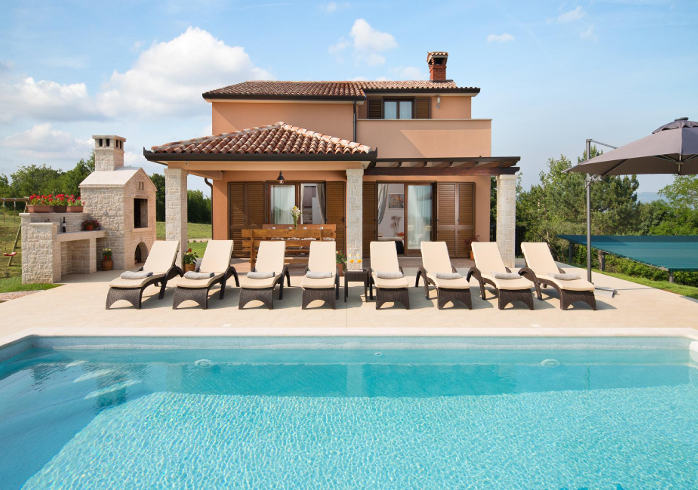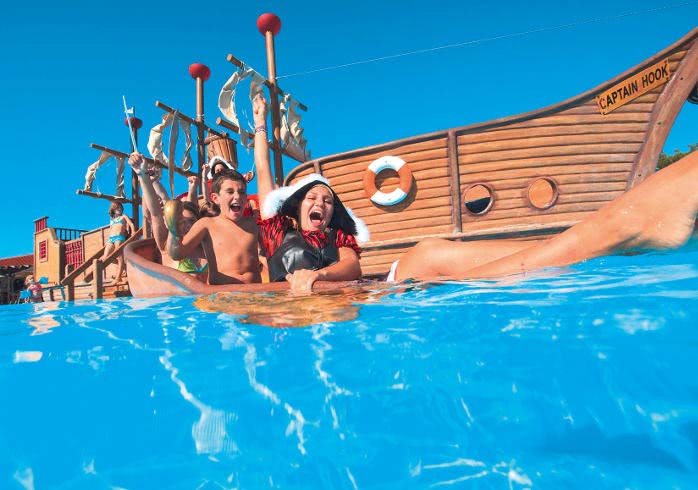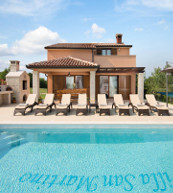Why aren't all the offers displayed?
map
This is how holiday rental owners described Nin
History of Nin
The past for the present
Nin has a three thousand year old history, which is not only recorded in history books but the visitor literally walks on it, or learns about it from the rich museum collections. It was founded by the Ilyrian tribe of Liburnians in ...
show more the 9th century BC and known by the name Aenona. Thanks to archaeological excavations in this place, the development of Liburnian culture can be followed. The settlement on the small island was surrounded by walls, and the houses were built using the drystone- wall technique, and judging from historical evidence the people were prosperous.
During the Roman rule, Nin was an important municipality and sea port. The remains of houses and the mozaics bear witness to a pleasant and wealthy lifestyle considering the circumstances. For trade purposes a large port was built located in the present day area of Zaton Holiday Resort. The most important complex from Roman times was the Forum with Capitolium. There was also a monumental temple, by size one of the biggest in our area. The level of development is supported by the fact that Nin at that time also had a water supply system and along with important public buildings, it is also supposed to have had a thermal bath and amphitheatre.
In its long history Nin was destroyed several times, but it rose again, only to be completely destroyed in 1646 when Venice sacrificed it in order to save the fort of Zadar from Turkish invasion. That end, as many times earlier was also its new beginning.
But what most clearly determines and connects the history of Nin with the present day, is the fact that it was the first political, religious and cultural centre of medieval Croatia. It was the place where the Croatian state was born. Nin is also the oldest Croatian royal town, a permanent or occasional seat of national rulers: dukes Višelav, Trpimir and Branimir, Kings Tomislav, Petar Krešimir IV. and Zvonimir, dukes Šubić from Bribir etc… Nin was a diocese from 9th -19th century. Nin's bishops were famous for the Croatian Church, among them the most prominent was Grgur Ninski, a fighter for the preservation of the Croatian folk script, glagolitic..
Rich archaeological finds from Nin's history can be seen in museums, illustrating how in the course of their history they have been deeply intertwined with the present of the oldest royal Croatian town, and the cradle of the Croatian state. Rarely does a visitor find such a rich history and dynamic present so intertwined as a tourist offer, and all of this with just one wish: that the visitor has something to see and enjoy, and because of this will come back again.
Nin today
From an exciting past to a lovely present
On a small island in the middle of a shallow lagoon the small town of Nin can be found with its old centre, connected to the mainland by two stone bridges. Nin has had an exciting past and today a lovely present. All its stories, all its beauty and natural wealth are here to be enjoyed and to find joy, health and spiritual satisfaction which are so much needed today.
Nature and Man have made this small town very pleasant for a holiday, interesting because of the rich historical field, as well as excellent for health. It is the oldest Croatian royal town, the cradle of the Croatian state. The smallest cathedral in the world and the coronation Church of St. Nicholas can be found here, as well as one of the word's most beautiful beaches. Nin has a rich cultural treasure, unspoilt nature, as well as remarkably beautiful surroundings.
Nin is the European Destination of Excellence (EDEN). It is well known for its medicinal mud which reliably cures many illnesses. There is a saltworks producing salt before your very eyes and whose tradition is a thousand years old. Touching the big toe on the statue of Grgur Ninski – tradition has it-brings good luck. Indeed, one foreign portal has included it among the ten most attractive world symbols of luck. It is worth giving it a try!
Nin and its surroundings offers the visitor a fantastic well of experience, an active holiday where the present is interwoven with history resulting in a rich and valuable treasure which is permanently open to the public. Every new day becomes more beautiful than the day before. In a word, Nin has all the visitor may want and need, but definitely it offers more than one would expect. It is a small town where the visitor might have come unexpectedly the first time, but with every new visit a friend can be met who shares the same values.
Nin is an exceptional place. It is an on-going story. Welcome!
show less
The past for the present
Nin has a three thousand year old history, which is not only recorded in history books but the visitor literally walks on it, or learns about it from the rich museum collections. It was founded by the Ilyrian tribe of Liburnians in ...
show more the 9th century BC and known by the name Aenona. Thanks to archaeological excavations in this place, the development of Liburnian culture can be followed. The settlement on the small island was surrounded by walls, and the houses were built using the drystone- wall technique, and judging from historical evidence the people were prosperous.
During the Roman rule, Nin was an important municipality and sea port. The remains of houses and the mozaics bear witness to a pleasant and wealthy lifestyle considering the circumstances. For trade purposes a large port was built located in the present day area of Zaton Holiday Resort. The most important complex from Roman times was the Forum with Capitolium. There was also a monumental temple, by size one of the biggest in our area. The level of development is supported by the fact that Nin at that time also had a water supply system and along with important public buildings, it is also supposed to have had a thermal bath and amphitheatre.
In its long history Nin was destroyed several times, but it rose again, only to be completely destroyed in 1646 when Venice sacrificed it in order to save the fort of Zadar from Turkish invasion. That end, as many times earlier was also its new beginning.
But what most clearly determines and connects the history of Nin with the present day, is the fact that it was the first political, religious and cultural centre of medieval Croatia. It was the place where the Croatian state was born. Nin is also the oldest Croatian royal town, a permanent or occasional seat of national rulers: dukes Višelav, Trpimir and Branimir, Kings Tomislav, Petar Krešimir IV. and Zvonimir, dukes Šubić from Bribir etc… Nin was a diocese from 9th -19th century. Nin's bishops were famous for the Croatian Church, among them the most prominent was Grgur Ninski, a fighter for the preservation of the Croatian folk script, glagolitic..
Rich archaeological finds from Nin's history can be seen in museums, illustrating how in the course of their history they have been deeply intertwined with the present of the oldest royal Croatian town, and the cradle of the Croatian state. Rarely does a visitor find such a rich history and dynamic present so intertwined as a tourist offer, and all of this with just one wish: that the visitor has something to see and enjoy, and because of this will come back again.
Nin today
From an exciting past to a lovely present
On a small island in the middle of a shallow lagoon the small town of Nin can be found with its old centre, connected to the mainland by two stone bridges. Nin has had an exciting past and today a lovely present. All its stories, all its beauty and natural wealth are here to be enjoyed and to find joy, health and spiritual satisfaction which are so much needed today.
Nature and Man have made this small town very pleasant for a holiday, interesting because of the rich historical field, as well as excellent for health. It is the oldest Croatian royal town, the cradle of the Croatian state. The smallest cathedral in the world and the coronation Church of St. Nicholas can be found here, as well as one of the word's most beautiful beaches. Nin has a rich cultural treasure, unspoilt nature, as well as remarkably beautiful surroundings.
Nin is the European Destination of Excellence (EDEN). It is well known for its medicinal mud which reliably cures many illnesses. There is a saltworks producing salt before your very eyes and whose tradition is a thousand years old. Touching the big toe on the statue of Grgur Ninski – tradition has it-brings good luck. Indeed, one foreign portal has included it among the ten most attractive world symbols of luck. It is worth giving it a try!
Nin and its surroundings offers the visitor a fantastic well of experience, an active holiday where the present is interwoven with history resulting in a rich and valuable treasure which is permanently open to the public. Every new day becomes more beautiful than the day before. In a word, Nin has all the visitor may want and need, but definitely it offers more than one would expect. It is a small town where the visitor might have come unexpectedly the first time, but with every new visit a friend can be met who shares the same values.
Nin is an exceptional place. It is an on-going story. Welcome!
show less
source: Zulj
Neighbouring holiday resorts Nin
-
Nin, Dalmatia (North Dalmatia)
Holiday apartment for max. 4 persons
Property no. 1926919
+ 1 moreApprox. 33 m², 1 bedroom, 1 bathroom, pets not allowed, satellite TV, Wifi, beach approx. 700 m, communal swimming poolThere is one further property type with one accommodation for this complex- Rental price on request Holiday apartment for max. 4 persons, approx. 42 m², 2 bedrooms, property no. 1926922 Preview
-
Nin, Dalmatia (North Dalmatia)
Holiday apartment for max. 5 persons
Property no. 2291649
+ 1 moreApprox. 70 m², 2 bedrooms, 2 bathrooms, pets not allowed, satellite TV, Wifi, washing machine, dishwasher, sandy beach approx. 10 mThere is one further property type with one accommodation for this complex- Rental price on request Holiday apartment for max. 5 persons, approx. 70 m², 2 bedrooms, property no. 2291650 Preview


















